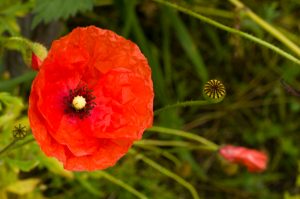The summer of 1914 was the beginning of World War 1. In summertime this year, it will mark 100 years since it began. In memory of those who fought and were affected by the war, RBGE is creating a poppy field within the Edinburgh Garden. The display will commemorate the employees who went to war, many of whom lost their lives, and will also remember others who were, or still are, affected by war.
During the First World War, areas of battle which had been bombed and destroyed created ideal conditions for poppies to flourish. Canadian Lieutenant Colonel John McCrae was inspired to write a memorable war poem In Flanders Fields from the sight of poppies which seemed as if they were healing the ruined earth. The flower is large, scarlet and has four petals and can lie dormant for many years before germination which is often triggered when the soil is disturbed.
The poppy field, to be located by the Glasshouse Lawn, will be sown in late may using the common poppy Papaver rhoeas, known as a symbol of remembrance and used to commemorate the Great War since 1921. The perimeter area was cut out on the 30 April and the field will cover 700 square metres with a circumference of 116 metres.
At the time of the Great War, 110 people worked in the Garden and of the 88 men, 73 joined the forces and 20 lost their lives in action.
Botanics Stories
RBGE Personal & Project Stories


1 Comment
1 Pingback